Introduction to Iranian Traditional Clothing
Iran’s traditional clothing is deeply rooted in the country’s rich history and cultural identity, serving as a visual narrative of its heritage. Dating back to ancient Persia, garments reflected social class, region, and religious beliefs. During the Achaemenid Empire (550–330 BCE), Persian kings and nobles adorned themselves with finely woven robes and gold-thread embroidery, symbolizing wealth and power. This tradition of intricate craftsmanship persists, especially in regions like Isfahan and Kashan, known for their textiles.
Throughout centuries, regional variations evolved based on local climates and customs. For instance, the flowing garments of southern Iran offered comfort in the heat, while heavier woolen attire in the north protected against colder weather. The Islamic influence after the 7th century introduced modesty-focused elements like the chador and headscarf, blending traditional styles with religious principles.
Iranian clothing continues to celebrate artistry, with patterns and colors inspired by Persian carpets and architectural designs. Whether through ceremonial attire or everyday wear in rural areas, these garments honor the past while preserving a distinct cultural identity. Museums, such as the National Museum of Iran, and festivals like Nowruz provide opportunities for visitors to appreciate this living tradition, connecting modern audiences to its timeless legacy.
How Geography, Climate, and Cultural Diversity Shaped Iran’s Traditional Styles
Iran’s vast and varied landscape has played a key role in shaping its traditional clothing styles. Stretching from arid deserts to lush green forests and snow-capped mountains, the country’s geography influences both the materials and designs of its garments. For example, in the cold regions of northern Iran, like Gilan and Mazandaran, people traditionally wore thick, layered clothing made from wool to keep warm during harsh winters. In contrast, the southern provinces, such as Khuzestan and Hormozgan, known for their hot and humid climate, have lightweight, breathable fabrics like cotton and linen incorporated into their attire.
Cultural diversity adds another layer of richness to Iranian fashion. With numerous ethnic groups, including Kurds, Baluchis, Azeris, and Qashqais, each region boasts unique patterns, colors, and embroidery styles. Kurdish outfits often feature vibrant colors and metallic embellishments, reflecting the energy of their dance and celebrations. Baluchi attire is renowned for its intricate hand-stitched embroidery, reflecting centuries of artistry.
These traditional styles are not just practical but also deeply symbolic. The choice of fabric, patterns, and colors often reflects social status, local customs, or religious beliefs. This diversity, rooted in Iran’s geography and culture, ensures that every piece of traditional clothing tells a story of adaptation and identity.
Regional Diversity in Iranian Clothing
Northern Regions (Caspian areas)
The Caspian region of northern Iran, encompassing provinces like Gilan and Mazandaran, is celebrated for its lush green landscapes and humid climate, which significantly influence the traditional attire of its people. In these regions, practicality and comfort blend seamlessly with aesthetics. The clothing is designed to adapt to the damp weather while reflecting local cultural values.
Women in this area often wear long, colorful skirts and blouses made of lightweight fabrics like cotton, suitable for the humid environment. These garments are paired with scarves or shawls, known locally as “روسری” (rusari), often adorned with floral patterns that mirror the natural beauty of the region. Men typically wear long-sleeved shirts and loose trousers, complemented by vests or jackets made from thicker material during the colder months.
Traditional clothing in the Caspian areas also incorporates vibrant colors, especially reds and yellows, symbolizing energy and joy. The embroidery on these garments often features motifs inspired by the surrounding nature, such as flowers, vines, and birds. This attention to detail reflects the region’s rich artistic heritage and deep connection to the environment.
Festivals and ceremonies provide a wonderful opportunity to see these traditional outfits in their full glory. For example, during wedding celebrations, women wear intricately embroidered dresses, and men don tailored jackets known as “کوتاه” (kutah). The combination of practicality, beauty, and cultural symbolism makes the clothing of northern Iran a vivid testament to the region’s identity.
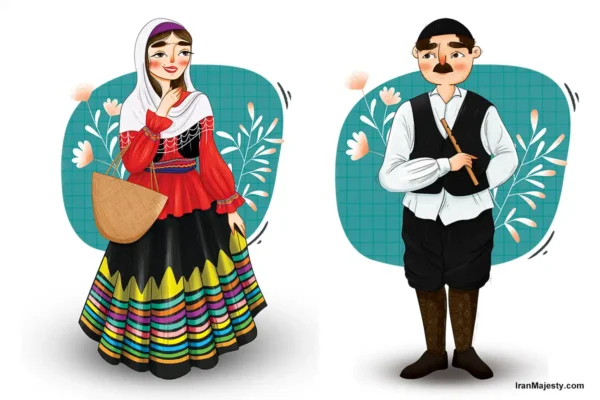
Western Regions (Kurdish clothing)
Kurdish traditional clothing, worn predominantly in Iran’s western provinces like Kermanshah, Kurdistan, and Ilam, is one of the most vibrant and intricate styles of Iranian attire. Deeply rooted in Kurdish culture and history, this clothing reflects a blend of practicality, symbolism, and artistry, adapted to the mountainous terrain and varying climates of the region.
For women, Kurdish attire includes long, flowing dresses called “kras”, often made from shimmering fabrics like silk or velvet, adorned with sequins and elaborate embroidery. These dresses are typically layered with vests or jackets called “claka”, which add both style and warmth. Women also wear colorful, embroidered scarves or headpieces, incorporating beads or coins, symbolizing prosperity and cultural pride. Accessories like wide belts, known as “pashmineh”, further accentuate the outfit and add a touch of elegance.
For men, the traditional outfit is equally striking, consisting of a long-sleeved shirt and baggy trousers called “shalvar”. These trousers are fastened with a broad cloth belt called “posh”, which is often wrapped multiple times. A vest or coat completes the look, providing a dignified and practical style that suits the rugged lifestyle of the region. Additionally, the “kolah” or Kurdish hat is an essential element of male attire, often tailored to specific cultural and familial traditions.
Kurdish clothing is not only practical but also serves as a medium for cultural storytelling. The patterns, colors, and styles often signify a wearer’s tribe, marital status, or regional origin. Traditional dances and celebrations like Newroz (Kurdish New Year) provide a perfect occasion to showcase these garments in their full splendor. Observing Kurdish clothing in such settings offers a fascinating insight into the resilience and creativity of this community.
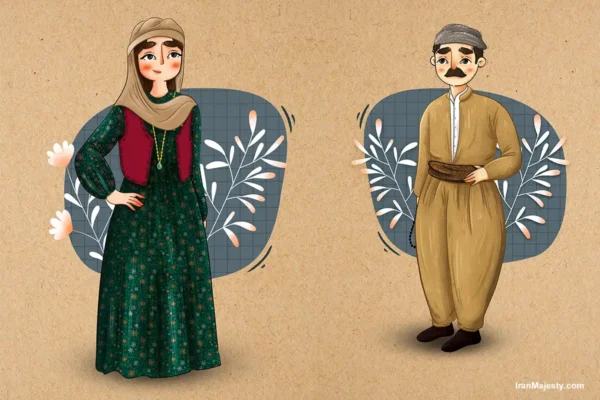
Southern Regions (Persian Gulf)
The traditional clothing of Iran’s southern regions, particularly those along the Persian Gulf, embodies the unique interplay of the area’s tropical climate, cultural influences, and seafaring history. The attire here is both functional and aesthetically captivating, reflecting the lifestyle and traditions of coastal communities.
For women, the most distinctive element is the “bandari” attire, characterized by vibrant colors, intricate embroidery, and practical designs suited to the warm, humid weather. Women often wear long dresses called “kandoura”, which are lightweight and adorned with dazzling patterns. These are paired with colorful scarves or veils, such as the “boshiya”, offering both modesty and protection from the sun. An iconic feature of southern women’s attire is the “burqa”, a face covering traditionally used for cultural and practical reasons, which varies in design across different communities.
Men’s clothing in the region is simple yet symbolic, often featuring loose, white or light-colored garments to reflect heat and ensure comfort. The “dishdasha” or “thobe”, a long tunic, is commonly worn alongside a headpiece such as the “ghutrah” or “keffiyeh”, which protects against the sun and sand. These garments often highlight the wearer’s connection to both Iranian and broader Gulf traditions.
The southern region’s proximity to the Arabian Peninsula and historical trade connections with India and Africa have infused its traditional attire with unique patterns and motifs. Festivals like Qeshm’s Turtle Festival or Hormuz Island celebrations are perfect occasions to witness these vibrant outfits in action. Observing the clothing of the Persian Gulf not only reveals the region’s resourceful adaptation to its environment but also its rich cultural exchanges over centuries.
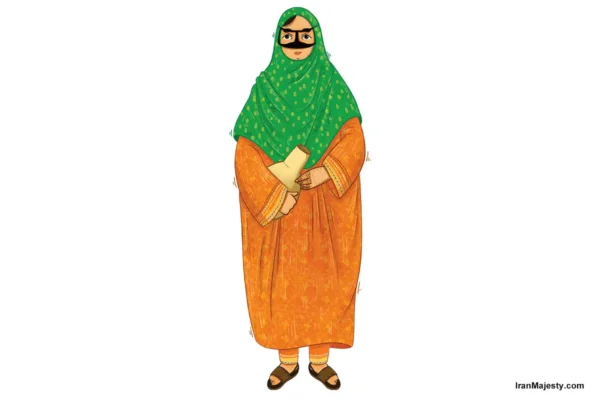
Eastern Regions (Baluch clothing)
The Baluch people, who primarily inhabit Iran’s eastern regions, near the borders with Pakistan and Afghanistan, showcase a rich and diverse traditional clothing style that reflects their unique culture, harsh climate, and history of interactions with neighboring regions. The traditional attire of the Baluch people is not only functional but also deeply intertwined with their social identity and heritage.
Men’s clothing in Baluch communities is designed for the intense heat of the region’s desert landscapes, where breathable, loose-fitting clothes are essential. The “kandura” or “shalwar kameez”, a long shirt paired with loose trousers, is the primary garment worn by men. These clothes are usually made from light cotton or linen to keep the body cool. In addition to the tunic, men often wear a “pashmina” (a type of scarf or shawl) around the shoulders, which can be used as both a head covering or as protection from the sun. Their clothing is often simple, in earthy tones like beige, brown, and white, but intricate embroidery and stitching often adorn the garments, especially on cuffs or collars.
For women, Baluch clothing is characterized by bright colors and beautiful embroidery that serve both aesthetic and symbolic purposes. The “baluchi dress” for women includes long tunics, skirts, and head coverings. The dresses are known for their vibrant, contrasting colors such as red, yellow, and green, which reflect the natural beauty of the region and the rich culture of the Baluch people. The “purdah”, a form of head covering or veil, is commonly worn by women, symbolizing modesty and tradition.
What makes Baluch clothing particularly unique is the intricate embroidery. This needlework, often done by hand, is passed down from generation to generation and serves as a visual representation of cultural identity. The embroidery is typically geometric, floral, or symbolic, and each Baluch community has its own distinctive style. Women play an essential role in the preservation of these traditions, and the skill is often seen as a rite of passage.
Footwear is another important element of Baluch traditional clothing. Men and women both wear leather sandals or boots that are often handmade and decorated. These practical shoes are well-suited for the rocky, arid terrain of the region and are a testament to the Baluch people’s craftsmanship.
Beyond clothing, color symbolism is a vital aspect of Baluch dress. The vibrant, contrasting colors used in their attire are not just for decoration but hold cultural significance. For instance, red often represents joy and celebration, while green symbolizes fertility and connection to the earth.
When visiting Sistan and Baluchestan province, it’s impossible to miss the striking beauty and meaning behind the traditional clothing worn by the Baluch people. The region’s traditional garments provide insight into their history, values, and social structures, making them an essential part of the cultural landscape in Iran’s east. These clothes are not just practical garments but are woven with stories of resilience, family, and pride.
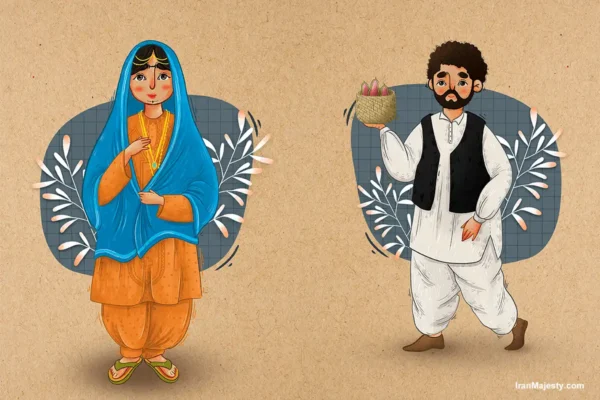
Central Regions
The central regions of Iran, including cities like Isfahan, Yazd, and Kerman, have a clothing style that reflects the unique climatic conditions and rich cultural history of this area. These regions, with their hot and arid climates, have developed traditional clothing that is both practical for the heat and symbolic of the people’s lifestyle and artistry.
In the central part of Iran, traditional clothing for men often consists of a long tunic called a “kameez”, paired with trousers or loose-fitting pants. This attire is usually made from cotton or linen to allow for breathability and comfort in the dry, hot weather. Men often wear head coverings, such as scarves or hats, for sun protection. In Isfahan, for example, men may wear a chador (a long robe or cloak) over their clothing during special occasions or religious ceremonies, reflecting the region’s Persian cultural heritage and religious significance.
For women, traditional clothing in central Iran also prioritizes comfort in hot conditions but is more decorative than that worn by men. Women in cities like Yazd and Isfahan often wear long dresses or tunics made from light fabrics, along with scarves and shawls to cover their heads. The style of dress is often influenced by both Persian and Islamic traditions. A characteristic feature is the “chador”, a full-body cloak worn by many women in the region. The “manteau”, a long jacket worn over a dress, is also common in the central regions, reflecting the blend of traditional and modern influences.
The clothing of the central regions often features intricate embroidery and decorative patterns, a skill passed down through generations. Isfahan, known for its silk industry, has particularly notable textiles. The clothing is often adorned with silk threads and bright colors, reflecting the region’s historical connections to trade routes, especially the famous Silk Road.
The nomadic tribes of the central Iranian plateau, like the Qashqai, have also contributed to the region’s rich clothing styles. Their woven woolen textiles, often dyed in vivid reds and blues, feature geometric patterns and are worn both as outer garments and blankets. These pieces of clothing are highly prized for their craftsmanship and ability to withstand the harsh desert winds.
In terms of footwear, sandals made from leather or fabric are common, well-suited to the hot and dry climate. These sandals are often handmade, using traditional techniques that date back centuries. The central region’s clothing also reflects the artistry and craftsmanship of its people, who have long been known for their weaving, embroidery, and textile-making skills.
The variety of clothing in central Iran is a living testament to the region’s cultural richness, resilience, and creativity. When you visit this area, the clothing you see tells the story of the people’s connection to their environment, their heritage, and the influences that have shaped this part of the world for centuries. It is not only functional but also a beautiful reflection of Iranian identity, craftsmanship, and traditions.
Key Elements of Traditional Iranian Attire
Traditional Iranian attire is known for its elegance, practicality, and diversity, reflecting the country’s rich cultural history, regional influences, and unique geography. Several key elements stand out in the design of Iranian clothing, with each one contributing to its distinctiveness.
1. Head Coverings
Head coverings, especially for women, are one of the most iconic aspects of traditional Iranian attire. The chador is a full-body cloak worn by many women across Iran, particularly in more conservative regions. It covers the entire body, leaving only the face exposed, and is made from various fabrics, often in dark colors like black or navy blue. For more practical and daily use, women wear a hijab or scarf, which is usually paired with a loose manteau (coat) to maintain modesty, especially in urban areas. For men, head coverings like turbans or caps are common, especially in religious or traditional settings.
2. Loose and Flowing Garments
In response to Iran’s hot and dry climate, traditional Iranian attire is often made from light, breathable fabrics such as cotton, linen, or silk. This choice of material ensures comfort in the heat. The kameez (shirt) or shalwar (pants) is a traditional piece of clothing for both men and women in many regions. These garments are usually loose-fitting, allowing for free movement and airflow, which is essential in the arid regions of Iran.
3. Layered Clothing
The layering of clothing is a hallmark of many traditional Iranian outfits. Men often wear a long tunic or robe over their pants, while women’s traditional outfits might include a dress with a mantle or jacket on top. This layering not only offers protection from the harsh sun but also provides versatility, allowing individuals to adjust their clothing based on the weather and occasion.
4. Textiles and Fabrics
Iran has a rich tradition of textile production, with certain regions renowned for their fabric-making expertise. In Isfahan, silk and brocade textiles are famously woven into intricate patterns, used in the making of royal garments and formal wear. In Kerman and Yazd, cotton and woolen textiles are more common, often dyed in vibrant colors and patterns, showcasing the local artistry. Additionally, embroidered designs, often inspired by nature, are a common feature, adding elegance and color to traditional garments.
5. Accessories and Footwear
Accessories play an essential role in Iranian traditional attire. Jewelry, such as necklaces, bracelets, and earrings, is frequently worn, with many pieces made from silver or gold. In more rural areas, belts are worn by both men and women, often adorned with coins or ornamental decorations. Traditional Iranian footwear includes sandals made from leather or woven fabrics, suitable for the diverse terrains across the country. In colder regions, boots made from wool or felt are common.
6. Symbolism and Colors
The choice of colors and patterns in Iranian traditional clothing is not just for aesthetic purposes; they often carry cultural or spiritual significance. For example, the color black is frequently worn by women, especially the chador, symbolizing modesty and respect. Meanwhile, in other regions, more vibrant colors like red, blue, and green are often used, reflecting the local culture and historical ties to the Silk Road trade.
7. Traditional Clothing for Special Occasions
Special occasions, such as weddings, religious holidays, and festivals, call for even more elaborate attire. During weddings, both men and women often wear ornate clothing, featuring rich fabrics and detailed embroidery. Men’s formal wear may include a long coat or kaftan, while women’s formal dresses can be adorned with gold thread and beads. These garments often showcase Iran’s fine craftsmanship and deep cultural significance, linking the past to the present.
Traditional Iranian clothing, while diverse, reflects a deep connection to the land, climate, and cultural history. Each element, from materials to colors, is designed not just for practicality but also to express the beauty, art, and spirituality of Iran’s people. Understanding these garments provides a richer perspective on Iranian life and identity, making it easy to see how closely clothing is intertwined with the nation’s rich heritage.
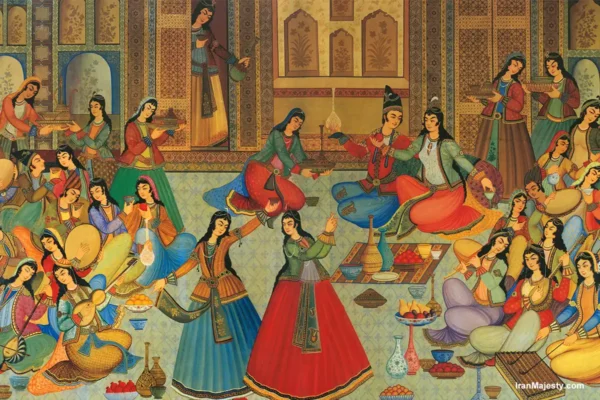
Historical Evolution of Iranian Clothing
The evolution of Iranian clothing is deeply rooted in the country’s history, reflecting shifts in culture, religion, politics, and geography. Traditional attire, which evolved over centuries, has been significantly influenced by both domestic and external factors, including the rise of different dynasties and modern Western influences.
Early Influences and Traditional Roots
Historically, Iranian clothing was shaped by the unique needs and environments of different regions. The ancient Persians, such as those in the Achaemenid Empire (550–330 BCE), were known for their elaborate costumes, often crafted from luxurious materials like silk and wool. Men typically wore long tunics with fitted sleeves, while women donned dresses with pleats, belts, and veils. The styles were not only a reflection of social status but also a way to adapt to Iran’s diverse climate.
During the Safavid period (1501-1736), Iranian clothing became more standardized, with significant royal influence shaping fashion trends. Men’s garments included long robes, trousers, and turbans, while women’s attire featured chadors, richly embroidered tunics, and silk scarves. These styles carried symbolic meaning, signifying nobility and religious devotion, and were later embraced by different regions of Iran.
Western Influence and Modernization
The major shift in Iranian fashion came in the late 19th and early 20th centuries, especially under the Qajar dynasty (1789-1925), when Iran opened up to Western ideas. This was a time of significant modernization and reform, which brought European styles into Iranian clothing. Men, in particular, began wearing Western-style suits and trousers, which contrasted with the more traditional, flowing robes of earlier times.
The Pahlavi era (1925-1979) accelerated this modernization process. Reza Shah, the founder of the Pahlavi dynasty, introduced policies to Westernize Iranian society, including clothing. In 1936, he issued a decree banning the chador in public, pushing for more Western-style clothing such as suits for men and dresses for women. During this period, Iranian women began adopting modern Western outfits, while men moved away from traditional garments like the pirahan (robe) and kulah (hat).
However, this period of Westernization faced significant resistance from various groups, leading to a cultural clash between modernization and the preservation of traditional values.
Post-Revolutionary Changes and Return to Tradition
The 1979 Islamic Revolution in Iran brought about a profound change in the country’s clothing styles, particularly for women. The new Islamic government reinstated modesty laws that required women to cover their hair and bodies with the hijab and chador in public. These laws, while politically charged, also revived traditional Iranian clothing in a modern context, blending old and new elements.
This era also saw the rise of Iranian designer fashion, where elements of traditional attire, such as the chador or manteau (coat), were modernized with contemporary cuts, fabrics, and colors. This blend of modern and traditional attire continues to shape the clothing of both men and women today. Many designers have integrated Persian embroidery and patterns into modern designs, creating garments that reflect Iran’s rich cultural heritage while also being fashionable and practical for daily life.
Today’s Fashion Scene
In modern-day Iran, the landscape of clothing continues to reflect the country’s rich history and complex cultural evolution. Young people, particularly in cities like Tehran, now wear a mix of traditional and global styles. Women often pair the hijab with stylish jackets, pants, or skirts, while men can be seen wearing Western-style jeans, shirts, and jackets, especially in urban centers. However, the influence of Iranian design remains evident in the fabrics and embroidery used in modern attire.
Traditional clothing in Iran is not just a symbol of cultural pride but also a reflection of national identity. Over time, Iranian clothing has adapted to global trends, yet it maintains its unique cultural significance. This dynamic balance between tradition and modernity is what makes Iranian fashion so distinctive today—an ongoing dialogue between the country’s ancient customs and its contemporary global presence.
Understanding the historical trajectory of Iranian clothing offers a lens into the broader cultural, social, and political changes that have shaped the nation. As Iran continues to navigate its way through modernization while preserving its rich cultural heritage, the evolution of its clothing provides valuable insights into the spirit and resilience of its people.
Significance of Colors and Patterns in Iranian Traditional Clothing
Colors and patterns in Iranian traditional clothing hold deep cultural and symbolic significance, reflecting the country’s rich history, beliefs, and regional diversity. These elements are not simply decorative; they serve as expressions of identity, social status, and cultural values. From vibrant reds and blues to the intricate floral motifs and geometric designs, each piece of clothing tells a story.
In Iran, colors in clothing often carry significant meaning, both spiritual and cultural. For example, red is a powerful and vibrant color, often associated with life, passion, and energy. In many rural and tribal regions, red clothing is frequently worn for celebrations or important life events, as it symbolizes vitality and festivity. Similarly, blue, a color that represents purity and spirituality, is often seen in the attire of religious and ceremonial contexts. Black holds a solemn, respectful connotation, often worn during mourning or somber occasions. Yellow and green, on the other hand, signify fertility and prosperity, respectively, and are commonly used in the attire of farmers or those involved in agricultural activities.
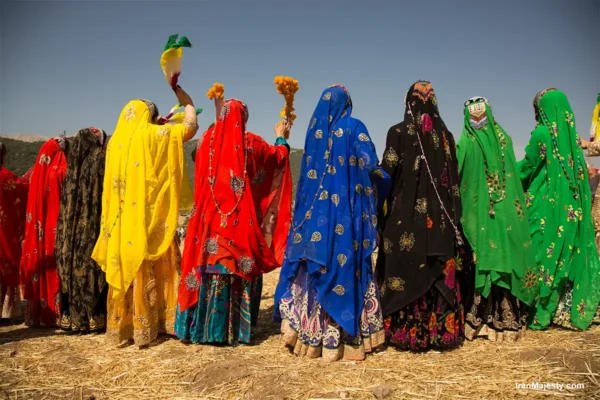
Patterns and Motifs
Iranian clothing patterns are incredibly diverse, influenced by historical events, regional customs, and religious beliefs. One of the most notable patterns is paisley, which originated in ancient Persia and has remained a symbol of Iranian culture throughout the centuries. Floral patterns are also significant in Persian textiles, often symbolizing nature’s abundance and connection to the divine. These intricate designs are not only beautiful but also carry deeper cultural meanings, with flowers like the lotus symbolizing purity, and pomegranate patterns representing fertility and eternal life.
In nomadic and tribal clothing, especially among the Kurdish, Baluch, and Turkmen groups, patterns often convey the wearer’s tribal identity and family history. Each tribe or community has its own unique set of designs, often passed down through generations. The use of geometric patterns in these textiles signifies balance and harmony, while zigzag and diamond patterns often symbolize protection and strength.
Regional Variations
The variety of colors and patterns in Iranian clothing also reflects the geographical diversity of the country. In the northern Caspian region, where the climate is cooler and more temperate, clothing tends to be made from heavier fabrics in darker shades, often featuring floral motifs. In contrast, the southern coastal regions, where temperatures soar, lighter fabrics are used, and the colors are often brighter and more vibrant, with waves and marine life patterns prominently featured. This diversity is a direct result of the country’s multicultural and multiregional makeup.
Through these colors and patterns, Iranian clothing not only represents aesthetic values but also communicates messages about social hierarchy, family affiliation, and cultural pride. The clothing of each region tells the story of its people and their connection to the land, making it a key part of Iran’s cultural fabric.
Today, modern Iranian designers continue to incorporate these traditional motifs, blending them with contemporary trends to create a unique fusion of the past and present. The significance of colors and patterns remains an essential part of Iranian identity, serving as a cultural bridge between generations while adapting to the ever-changing global fashion landscape.
Clothing for Festivals and Ceremonies in Iran
In Iran, clothing for festivals and ceremonies is deeply rooted in cultural traditions, often reflecting the rich history, religious beliefs, and regional practices of the country. Whether it’s for Nowruz, the Persian New Year, or the religious celebrations like Eid and Ashura, attire plays an essential role in conveying respect for the occasion, social status, and regional identity. The clothing worn during these events is not just about fashion; it carries deep symbolic meaning and helps maintain cultural continuity across generations.
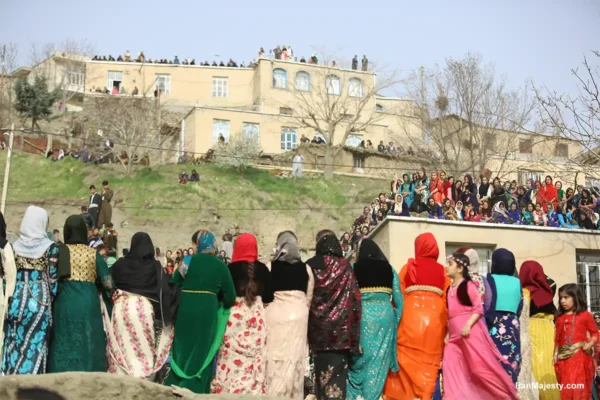
Nowruz (Persian New Year)
One of the most important festivals in Iran is Nowruz, the Persian New Year, which marks the beginning of spring and the renewal of nature. Traditionally, people wear their finest clothes during this time, often in vibrant colors symbolizing joy, prosperity, and vitality. For women, elaborate silk or velvet dresses are common, with intricate embroidery and patterns that highlight regional customs. Men typically wear traditional suits, which are usually complemented by a vest and a turban or cap, depending on the region. The colors chosen are often bright and cheerful, such as reds, yellows, and blues, to reflect the renewal of life.
Religious Celebrations
For major religious holidays like Eid al-Fitr and Eid al-Adha, clothing also reflects the spirit of the occasion. During Eid, people wear new clothes as a symbol of renewal and to mark the completion of fasting during Ramadan. The clothing often includes elegant dresses, especially for women, who might choose long, flowing gowns paired with colorful scarves. Men also wear formal tunics or jackets, often in light fabrics, which help them stay comfortable during these important family gatherings.
In Ashura, commemorating the martyrdom of Imam Hussain, the dress code is often more somber. People wear black clothing, symbolizing mourning and respect for the tragedy. Women in black chadors or loose-fitting dresses, and men in dark robes or shirt and pants join in mourning processions, where they participate in rituals like chest-beating and reciting elegies.
Weddings and Special Occasions
Weddings in Iran are grand affairs, and the attire worn is a major part of the celebration. Brides often wear ornate, white gowns that are reminiscent of Western wedding dresses but with Iranian touches, such as gold thread embroidery or Persian patterns. In some regions, brides wear traditional colored dresses with rich silk or satin fabrics, often in shades of red, green, or blue, depending on the region and the family’s preferences. Grooms typically wear formal suits, but in some traditional ceremonies, they might also wear a long robe and turban.
At these events, the attire reflects social standing and family heritage, with wealthier families opting for more luxurious fabrics like satin or lace. These garments are not just a fashion statement but a way to honor family traditions and cultural history.
Cultural Festivals and Regional Wear
In regional festivals, the attire worn is a vibrant celebration of the country’s diverse cultures. For example, during the Fajr Festival (Tehran’s annual celebration of Persian culture), performers often wear costumes that represent different regions of Iran. The clothes are designed to reflect both local customs and the natural surroundings of each area. For example, in the Kurdish regions, the clothing may include embroidered vests, baggy pants, and bright scarves, while in southern Iran around the Persian Gulf, women wear colorful shawls and long tunics made from lightweight fabrics suitable for the hot climate.
These festival attires are worn not only to celebrate but also to preserve the traditional craftsmanship of different Iranian regions, including handmade textiles and embroidered patterns, which are unique to each community. This clothing acts as a visual representation of Iran’s diversity, uniting various cultures under the larger umbrella of Iranian heritage.
In conclusion, Iranian clothing for festivals and ceremonies is a significant reflection of the country’s cultural richness, history, and religious values. The garments worn are deeply symbolic, ranging from the joyous bright colors of Nowruz to the somber black attire of Ashura. Each festival and celebration has its own distinct attire that is tailored to its customs, local climate, and the people’s beliefs. This cultural fabric plays an important role in maintaining a sense of identity and continuity, offering a fascinating glimpse into Iranian life and heritage.
Preservation and Modern Influence on Iranian Traditional Clothing
The traditional clothing of Iran, with its rich diversity and centuries-old customs, continues to hold a significant place in the country’s culture today. However, like many traditional practices worldwide, Iranian attire has been influenced by modernity while also undergoing efforts to preserve its authenticity. The intersection of tradition and modernity presents a fascinating narrative of how clothing can evolve while retaining its deep cultural roots.
Preservation Efforts
Iranian traditional clothing has long been a symbol of cultural identity and pride. Various efforts have been made over the years to preserve these garments and the techniques used to create them. In cities like Isfahan and Shiraz, where traditional textiles and embroidery have been a part of daily life for centuries, local artisans continue to produce handwoven fabrics and garments, often using techniques passed down through generations. This practice not only keeps cultural traditions alive but also supports the local economy and promotes the survival of ancient crafts.
The Iranian government, alongside cultural organizations, has also initiated projects to protect traditional clothing as part of the country’s heritage. In recent years, there have been museum exhibits showcasing the history of Persian dress and embroidery, helping to educate the public and preserve historical garments. For example, in Tehran’s Museum of Decorative Arts, visitors can explore examples of traditional costumes from different Iranian regions. Such museums provide a window into Iran’s cultural past, while also reminding modern generations of the beauty and significance of these timeless clothes.
Modern Influence
While efforts to preserve Iranian traditional clothing are ongoing, modern influences have also shaped the way people dress in Iran today. The globalization of fashion and the rapid changes brought on by modern technology have made Western-style clothing much more accessible in urban areas. Jeans, t-shirts, and suits have become common in daily life, especially in larger cities like Tehran and Shiraz. This trend, however, does not mean that traditional attire has disappeared altogether. Many Iranians, especially in rural areas, continue to wear traditional clothing, often mixing it with modern elements, creating a unique blend of old and new.
The influence of fashion designers has also been crucial in adapting traditional elements for contemporary tastes. Some Iranian designers now incorporate traditional Persian fabrics, embroideries, and patterns into modern clothing collections. These designs not only appeal to a younger, fashion-conscious audience but also serve as a way to reintroduce Persian heritage to the global fashion stage. For example, designers like Niloofar Fathi and Zahra Rastegar blend traditional Persian elements with global fashion trends, creating designs that respect cultural heritage while embracing modernity.
Challenges and Future Directions
The balance between preserving tradition and embracing modern trends is not without challenges. While some Iranian youth are embracing global fashion trends, there is concern that traditional clothing may gradually fade away, especially in urban areas. Environmental changes, such as urbanization and the migration of rural populations to cities, can also impact the practice of traditional dress.
However, the rise of social media and digital platforms has provided an unexpected opportunity for the preservation and promotion of Iranian traditional clothing. Platforms like Instagram have allowed designers, artisans, and cultural advocates to reach wider audiences. Influencers and fashion bloggers are increasingly using their platforms to promote traditional Iranian garments, helping to foster pride in the country’s cultural identity.
In conclusion, Iranian traditional clothing is navigating the intersection of preservation and modern influence. As it adapts to the globalized world, efforts to retain its rich history and cultural value continue to thrive. Both the artisans who craft these garments and the designers who innovate with them are ensuring that Iran’s clothing heritage remains a living, evolving part of its culture. This fusion of the old and the new not only enriches the country’s fashion scene but also preserves a tangible connection to Iran’s past, allowing future generations to continue to learn about and appreciate this essential aspect of Iranian identity.
Practical Advice for Travelers: Embracing Iranian Traditional Clothing
If you are planning to visit Iran and want to immerse yourself in the culture, understanding and respecting the local attire is an important part of the experience. Iranian traditional clothing is not just about fashion but also a reflection of the country’s rich heritage and values. Here are some practical tips to help travelers navigate Iranian clothing customs with confidence.
1. Respecting the Dress Code
Iran has a specific dress code, especially for women. While traveling in Iran, women are required to cover their hair and wear loose clothing that covers their arms and legs. This is particularly important in public places, religious sites, and government buildings. Hijab, the headscarf, is a key aspect of the dress code and is typically worn with a long coat or chador. Men are also expected to dress conservatively, avoiding shorts and wearing long pants.
When visiting rural areas or smaller cities, you may notice that traditional clothing like chadors or mantos (long coats) are more commonly worn by women. For men, wide-legged trousers and long shirts are traditional choices. In urban centers, modern styles blend with traditional influences, and you may see more western-style clothing alongside Iranian traditional wear. While it’s not required to wear traditional Iranian attire as a visitor, embracing the local dress can help you connect with the culture and gain respect from locals.
2. Appropriate Attire for Visiting Sacred Sites
If you’re planning to visit mosques, shrines, or other religious sites in Iran, it’s important to dress modestly out of respect for the sacred space. Women should wear a headscarf (which can be purchased in many shops) and loose-fitting clothing that covers their arms and legs. In some areas, you may be required to wear a chador (a full-body cloak). Men should also dress modestly by avoiding shorts and sleeveless shirts, especially when visiting religious or conservative areas.
In regions like Qom, known for its religious significance, you might encounter more people wearing traditional attire, including turbaned clergy in specific robes. The more conservative areas may have stricter dress codes, so always check local expectations before visiting.
3. Practical Tips for Buying Traditional Clothing
If you’re interested in purchasing traditional Iranian clothing as souvenirs, there are numerous markets across the country where you can find authentic Persian garments. For example, in Tehran, head to the famous Grand Bazaar where vendors sell everything from hand-woven Persian rugs to beautifully crafted traditional chadors and kaftans. Isfahan is another great place to find finely embroidered kerman silk and cotton fabrics used for traditional garments.
Bazaars in smaller towns may have more locally-made clothing, such as Kurdish outfits or Baluchi garments, which vary in style and color depending on the region. When buying traditional clothing, be mindful of the materials used (wool, cotton, and silk) and the intricate embroidery that often signifies the craftsmanship of a region.
4. Comfort and Climate Considerations
Iran’s geography, ranging from deserts to mountain ranges, means that the climate varies significantly across the country. In hot southern and eastern regions, like the Persian Gulf and Baluchistan, lightweight, breathable fabrics such as cotton are commonly worn. If you’re traveling to northern Iran (the Caspian Sea region) or the mountainous areas, you’ll encounter cooler temperatures, and woolen fabrics may be more appropriate. It’s important to dress according to the weather to stay comfortable while respecting local customs.
During summer months, you’ll find that clothing is designed to be breathable and light to allow for comfort during high temperatures. Loose-fitting attire helps protect against the heat while still covering the body in adherence to the dress code.
5. Understanding Regional Diversity
As mentioned previously, Iranian traditional clothing can vary significantly from region to region. Kurdish clothing in the western areas tends to be more colorful and ornate, while southern regions like the Persian Gulf are known for brightly colored cotton dresses. Baluchi clothing from the eastern regions is often made from lightweight fabrics and known for its intricate handmade patterns. If you’re traveling to a region with distinct traditions, try to explore local dress styles to understand how they reflect the culture, environment, and history.
In conclusion, understanding and respecting Iranian traditional clothing will enhance your cultural experience while traveling in Iran. By dressing modestly, exploring regional attire, and engaging with local customs, you’ll show respect for Iranian culture while making the most of your trip. Remember that your attire can be a sign of cultural understanding and will help you connect with the people you meet during your travels in this fascinating country.
Conclusion: The Enduring Legacy of Iranian Traditional Clothing
Iranian traditional clothing offers a fascinating lens through which we can explore the country’s deep cultural heritage, regional diversity, and historical evolution. What is especially intriguing is how the interplay of geography, climate, and historical influences has shaped the clothing traditions in each region. This diversity is not just about aesthetic preferences but is a testament to how different communities have adapted to their environments, social structures, and external influences over time.
One of the key takeaways from studying Iranian attire is how clothing continues to reflect the dynamic relationship between modernity and tradition. While urban areas like Tehran embrace a blend of contemporary fashion and traditional garments, rural areas still preserve distinct cultural identities through their clothing. This evolution offers a glimpse into the broader cultural shifts Iran has experienced, from pre-Islamic times to the present. Traditional clothing serves as a canvas for storytelling — from the intricately embroidered Kurdish jackets to the colorful Baluchi robes — each region’s attire tells a story of heritage, pride, and resilience.
Furthermore, the significance of color and pattern in Iranian clothing is not merely decorative; these elements carry symbolic meanings. For example, in the Persian Gulf, the vivid colors and floral patterns reflect the natural beauty of the region, while in Kurdish attire, colors often represent tribal affiliation or social status. These elements offer a window into the values and beliefs of the communities, enriching our understanding of Iran’s cultural fabric.
The preservation of these traditions, despite the pressures of globalization, is a compelling reflection of the enduring importance of cultural identity. Iranian clothing, while evolving in some aspects, remains a living tradition, a powerful symbol of community and continuity. As modern Iranian designers incorporate these historical influences into their work, they ensure that traditional clothing not only survives but thrives in the contemporary world.
For travelers and those interested in understanding the richness of Iranian culture, engaging with its traditional clothing offers more than just a visual experience — it is an invitation to explore the heart of a diverse and culturally vibrant nation. The clothing, whether worn for everyday use or during special ceremonies, serves as a testament to the beauty, history, and pride of Iran’s many peoples. Understanding and appreciating these garments allows visitors to connect with Iran on a deeper level, fostering respect and admiration for its multifaceted culture.
In this way, Iranian traditional clothing is not just a relic of the past but a dynamic, evolving expression of cultural identity. It is a symbol of how fashion and tradition can coexist, adapt, and thrive across generations.
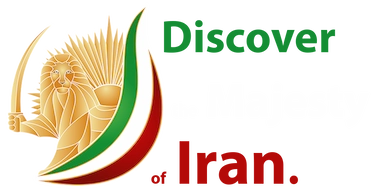
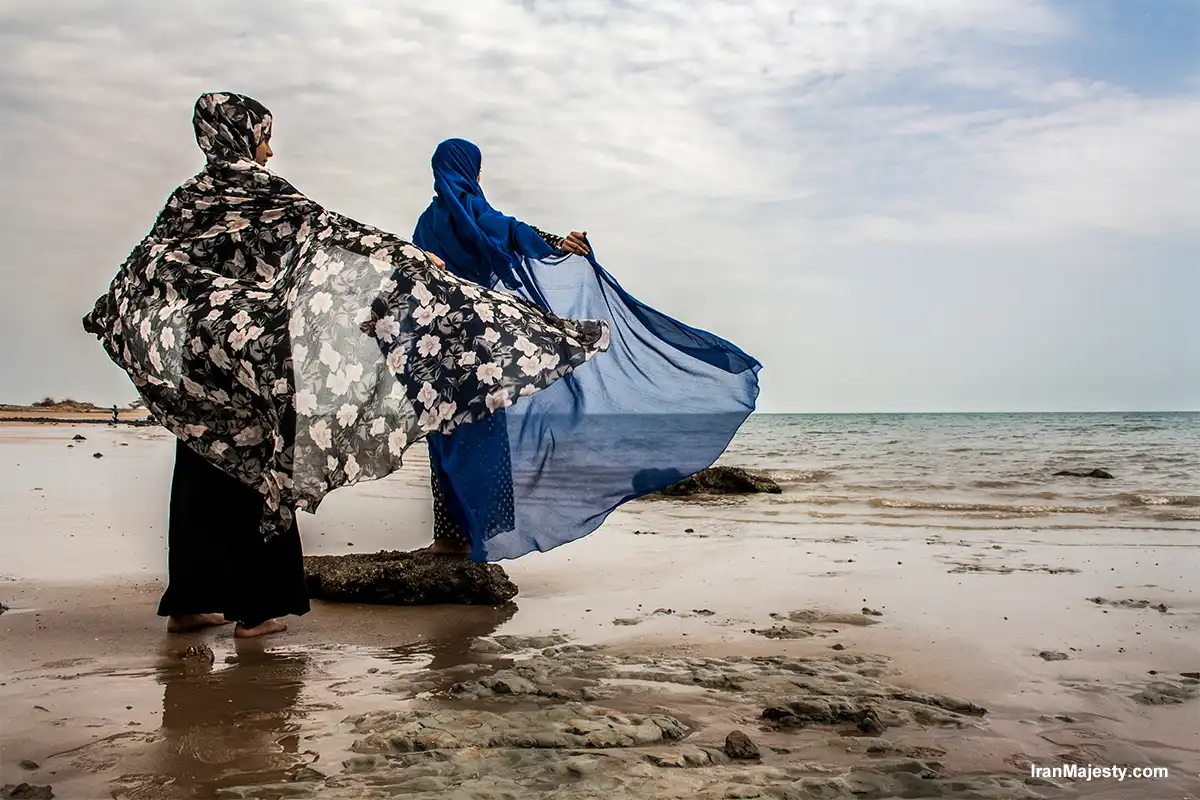
0 Comments